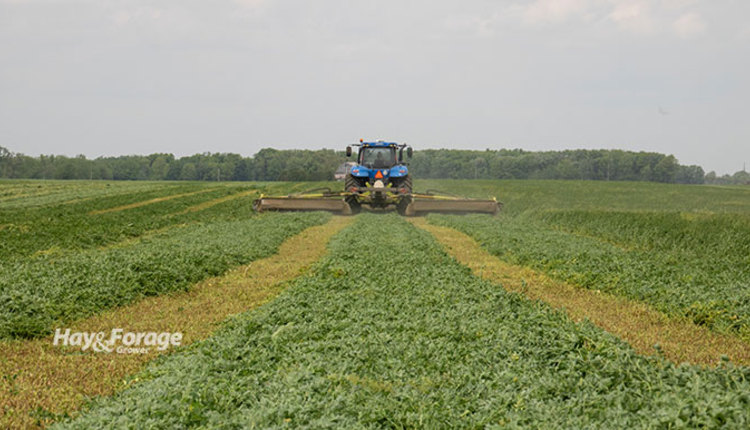
Respiration in plants involves the breakdown of starches and sugars to produce energy and carbon dioxide. While this process is necessary for plant growth, forage continues to respire after it is cut for hay, which can compromise dry matter and forage quality.
In an article from the Midwest Forage Association’s Clippings newsletter, Dan Undersander, emeritus professor and forage specialist with the University of Wisconsin–Madison, notes 2% to 8% of forage dry matter is lost due to respiration after cutting. Dry matter loss tends to be greater when forage is put in narrow windrows because less leaf area is exposed to the sun and stomates have limited capacity for gas exchange.
Furthermore, forage quality declines during respiration because starches and sugars are highly digestible nutrients. Breaking these components down ultimately raises the percentage of less digestible nutrients in forage and elevates its neutral detergent fiber (NDF) content.
“A 4-percentage unit loss in starch or sugar loss would increase NDF slightly over 3 percentage units. Note that this is a drop of almost 20 points of relative forage quality,” Undersander writes. “Thus, if one had alfalfa at just below 40% NDF and lost 4 percentage units of starch or sugar, the harvested quality would be above 40% NDF.”
Undersander explains that forage is usually 75% to 78% moisture immediately after it is cut; however, respiration rates don’t start to slow until forage is 60% moisture or less. Therefore, it is critical to lower moisture levels to this range as soon as possible to minimize dry matter and forage quality losses.
Make wide swaths
One strategy to reduce respiration is spreading forage into wide swaths after cutting. Undersander states this improves sunlight interception and allows stomates to breathe, which encourages more rapid drying of leaves.
“Hay put immediately into a windrow dries slowly within it and has high respiration rates for an extended time. Thus, growers should spread cut hay into a wide swath rather than make a windrow that fits between the wheels,” Undersander suggests.
Another solution to reduce respiration is to chop forage for haylage or make baleage. Both approaches protect forage from oxygen, which is needed to carry out respiration. By storing haylage in a covered pile or wrapping baleage in plastic, respiration will eventually cease.
“This practice is most effective at reducing respiration losses if combined with forage put into a wide swath at cutting, dried quickly to 60% to 65% moisture, then ensiled or wrapped in a bale,” Undersander asserts.
If creating wide swaths is not an option, Undersander suggests cutting hay sooner to maintain better forage quality despite greater respiration rates that occur in narrow windrows. With that said, an earlier harvest will result in less yield and may cause more plant stress throughout the forage stand.

